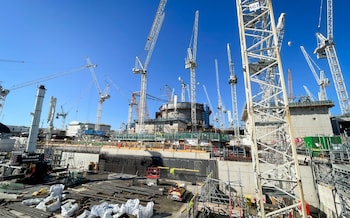A US energy giant has chosen South Yorkshire to host a landmark £1.5bn factory building the next generation of nuclear reactors in a major boost for the region.
Holtec, a privately owned nuclear company headquartered in Florida, is looking at sites across the county including around the city of Doncaster, where Energy Secretary Ed Miliband has his constituency.
If built, the £1.5bn factory could create up to 3,000 high-tech jobs to produce the components for small modular reactors (SMRs), the technology which could become the backbone of the UK’s planned nuclear revival.
The firm, which specialises in nuclear energy, has been searching for suitable sites with rival options in the West Midlands, Cumbria and Teesside considered.
Holtec Britain director Gareth Thomas said South Yorkshire had become the company’s preferred choice.
He said: “Holtec Britain was impressed by the resounding interest in our new SMR factory across the UK and the strong support received by the local authorities during our engagements.
“South Yorkshire overcame stiff competition from other areas of the UK to be our preferred location for our advanced SMR factory.”

Holtec was known to be interested in a particular site next to Doncaster-Sheffield Airport but a spokesman said three others had been shortlisted.
Sites in or close to Mr Milband’s Doncaster North constituency were under consideration.
South Yorkshire, which includes Sheffield, Barnsley and Doncaster, would hold many practical benefits for Holtec because of its proximity to Sheffield Forgemasters, which specialises in complex castings of the kind needed for building reactor housings.
The region’s history of heavy engineering and the many companies still operating in the sector also mean there would be a skilled workforce available.
Oliver Coppard, South Yorkshire mayor, said: “In South Yorkshire, we’re building on hundreds of years of innovation and engineering heritage to create world leading facilities, skills and expertise today; assets that will power the clean energy transition in the UK and beyond.
“We are right at the cutting edge of the new nuclear, hydrogen and sustainable aviation sectors, and proud to be home to the largest cleantech sector in the UK.”
SMRs are seen as a potential breakthrough technology that could dramatically reduce the cost of nuclear power plants and time taken to build them.
Mr Miliband has become a leading proponent of the idea, hoping they could prove cheaper to build and operate than plants such as Hinkley Point C, which has been plagued by cost overruns and delays.

Holtec is the largest exporter of capital nuclear components and commercial decommissioning company in the US, with 145 plants worldwide relying on Holtec for spent fuel storage & transport.
The idea behind SMRs is that they would be constructed from modules rather than built on-site from scratch like larger reactors. These could be produced in factories and then assembled on site.
Proponents say this ability to manufacture them en masse should make them far cheaper and quicker to produce at scale.
However, the technology, while technically sound, is untested and its commercial viability has not been proven.
As with other nuclear technologies, it will also generate toxic radioactive waste for which there is no facility for long-term storage as yet. This is because of decades of delays by successive governments in finding a location for a geological repository.
Holtec is one of five SMR companies seeking funding from the Government to build the country’s first reactors. The other candidates are Rolls-Royce, Westinghouse, GE Hitachi and NuScale.
Great British Nuclear, the government agency running the competition, is expected to whittle down the shortlist from five companies to four later this month.
Two winners are then expected to be chosen either late this year or in early 2025 and handed sites to develop.
Disclaimer: The copyright of this article belongs to the original author. Reposting this article is solely for the purpose of information dissemination and does not constitute any investment advice. If there is any infringement, please contact us immediately. We will make corrections or deletions as necessary. Thank you.



